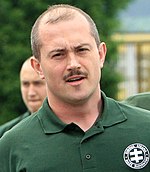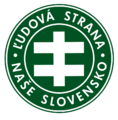Kotlebovci - Ľudová strana Naše Slovensko
| Kotlebovci - Ľudová strana Naše Slovensko Kotlebianer - People's Party Our Slovakia |
|
|---|---|

|
|

|
|
| Party leader | Marian Kotleba |
| founding | 2010 |
| Place of foundation | Bratislava |
| Headquarters | Kráľovoholská 6150/5, 97411 Banská Bystrica |
| Alignment |
Right-wing extremism nationalism anti-Semitism antiziganism neo-Nazism |
| Colours) | dark green (# 005222), white |
| Parliament seats |
17/150 ( National Council , 2020 ) |
| MEPs |
2/14 |
| European party | Alliance for Peace and Freedom |
| Website | naseslovensko.net |
Kotlebovci - Ľudová strana Naše Slovensko ( Slovak for Kotlebians - People's Party Our Slovakia , official party abbreviation ĽS Naše Slovensko , also spelled ĽSNS , ĽS NS or ĽS-NS ) is a Slovak party founded in 2010 . Political scientists and historians classify them as ultra-nationalist , right-wing extremist or neo-Nazi . Their supporters are called Kotlebovci in Slovakia after the party leader Marian Kotleba . The ĽSNS forms the political arm of the right-wing extremist association “Slovak Community” (Slovenská pospolitosť) .
After the regional elections in 2013 she set with party chief Kotleba the regional president of the state district Banská Bystrica . In the regional elections in 2017, however, he lost the post to the independent candidate Ján Lunter. In the national parliamentary elections in 2016 , the party achieved a share of the vote of 8.04% and was able to move into the National Council for the first time with 14 members .
Party names
- 2010–2016: Ľudová strana Naše Slovensko ( German People's Party Our Slovakia )
- 2016–2019: Kotleba - Ľudová strana Naše Slovensko ( German Kotleba - People's Party Our Slovakia )
- since 2019: Kotlebovci - Ľudová strana Naše Slovensko ( German Kotlebianer - People's Party Our Slovakia )
classification
The Slovak bourgeois political scientists Grigorij Mesežnikov and Oľga Gyárfašová (2013) describe the party as “ultra-nationalist-extremist”. The party uses the so-called Roma question for its radical calls and acts similar to the Jobbik in Hungary. Political scientists from the Center for Strategic & International Studies also categorized the party (2016) as “ultra-nationalist”. Bartek Pytlas (2016) classifies the party as “extreme right” . Erika Harris and Karen Henderson (2019) describe the Kotleba party as "pariah extreme-right". The Slovak historian and fascism researcher Jakub Drábik (2019) classifies in his standard work Fašizmus Kotleba's party as "at its core a neo-Nazi party that belongs to the larger family of the fascist movements".
After Kotleba's party entered the Slovak Parliament following the general election in 2016 , Rob Cameron assessed the ĽSNS for the British news agency BBC as follows:
“The term“ neo-Nazi ”is often used, sometimes foolishly, to denote anyone with views similar to Marine Le Pen's rights. But Marian Kotleba is different - he was once literally a neo-Nazi. Until recently he dressed in uniforms modeled after the Hlinka Guard , the militia of the Nazi-sponsored Slovak state from 1939 to 1945. He and his followers adapted the customs, greetings, symbols and rhetoric of this state, the first flirtation of the unhappy Slovakia with sovereignty. "
history
Forerunner and extra-parliamentary opposition (2005-2016)
The predecessor of the party was the Slovak Community - National Party , which existed from January 18, 2005 to early March 2006, when it was dissolved by the Supreme Court of the Slovak Republic because its activities were in conflict with the Slovak Constitution. It was the first time that a political party in Slovakia was dissolved by the Supreme Court. In February 2010 the party was re-established as Our Slovakia People's Party . The "leader" (Slovak Vodca ) of all these parties was and is Marian Kotleba . The party glorifies the Slovak state, which is allied with the National Socialist German Reich , and claims the establishment of a "new Slovak corporate state on a national, Christian and social basis" and the withdrawal of Slovakia from NATO .
The party caused a sensation primarily with its uniforms, which are similar to those of the fascist Hlinka Guard . The program items in the 2010 parliamentary elections , in which the party won 1.33 percent of the vote, included:
- the reduction of criminal responsibility to 12 years
- the establishment of a home guard
- lowering the retirement age to 60 and reducing the number of members of the National Council from 150 to 100
- Withdrawal of all Slovak soldiers from abroad.
In the early parliamentary elections in 2012 , she received 1.58 percent of the vote and thus remained without seats in the National Council .
In the regional elections on November 24, 2013, Marian Kotleba of the SSNS was surprisingly elected regional president of the Neusohler Landschaftsverband ( Slovakian Banskobystrický kraj ) for the first time. He won the runoff election against the Social Democratic incumbent Vladimir Maňka with 55.5 percent of the vote.
Against the background of the National Council election in Slovakia in 2016 , the party renamed itself Kotleba - Ľudová strana Naše Slovensko (German Kotleba - People's Party Our Slovakia ).
The ĽSNS as parliamentary party (since 2016)
In the 2016 National Council election, the ĽSNS achieved a surprising success and entered the Slovak National Council for the first time with 8.04% and 14 members. In the 2019 European elections , the party received the third-most votes of all parties in Slovakia with twelve percent and won two of the 13 Slovak seats.
On September 3, 2019, MP Milan Mazurek was deprived of his seat in Parliament after he was convicted by the Supreme Court in Bratislava for making racist statements against Roma. On November 17, 2019, the party renamed itself again to Kotlebovci - Ľudová strana Naše Slovensko .
Party symbolism
Until March 2018, the ĽSNS used a symbolism that was strongly reminiscent of that of the Hlinka Guard . The justification of the party leadership read:
"Urobili sme to pre to, aby sme sa jednoznačne dištancovali od všetkých spojení s fašizmom, nacizmom a kadejakými podobnými 'izmami', pretože často táto nálepka jednoducho dobráme"
"We did it to clearly distance ourselves from all connections with fascism, National Socialism and various similar '-isms', as this label often simply goes beyond all the good ideas we have available."
Election results
| year | be right | proportion of | Mandates | space |
|---|---|---|---|---|
| 2010 | 33 724 | 1.3% |
0/150 |
10. |
| 2012 | 40 460 | 1.6% |
0/150 |
10. |
| 2016 | 209 779 | 8.0% |
14/150 |
5. |
| 2020 | 229 660 | 8.0% |
17/150 |
4th |
| year | be right | proportion of | Mandates | space |
|---|---|---|---|---|
| 2014 | 9 749 | 1.7% |
0/13 |
11. |
| 2019 | 118 995 | 12.1% |
2/14 |
2. |

Web links
literature
- Jakub Drábik: Fašizmus. Premedia Publishing House, Bratislava 2019, ISBN 978-80-8159-781-7 . (Slovak)
Individual evidence
- ^ Register of Political Parties and Political Movements. Registration of the party at the Slovak Ministry of the Interior. In: ives.minv.sk. Retrieved May 26, 2019 .
- ↑ Grigorij Mesežnikov, Oľga Gyárfašová: The Slovak National Party: A fading Comet? On the Ups and Downs of Right-wing and National Populism in Slovakia . In: Karsten Grabow, Florian Hartleb (eds.): Exposing the Demagogues. Right-wing and National Populist Parties in Europe . Konrad-Adenauer-Stiftung / Center for European Studies, Berlin 2013, ISBN 978-2-930632-26-1 , p. 347 (English, kas.de [PDF; 17.4 MB ]).
- ↑ Heather A. Conley, James Mina, Ruslan Stefanov, Martin Vladimirov: The Kremlin Playbook: Understanding the Russian Influence in Central and Eastern Europe . CSIS / Rowman Littlefield, Lanham / Boulder / New York / London 2016, ISBN 978-1-4422-7958-2 , pp. 55 (English, amazonaws.com [PDF; 20.1 MB ]).
- ↑ Bartek Pytlas: Radical Right Parties in Central and Eastern Europe. Mainstream party competition and electoral fortune . Routledge, London / New York 2016, ISBN 978-1-138-88966-8 , pp. 224 (English).
- ↑ Erika Harris, Karen Henderson: Slovakia since 1989. In: Sabrina P. Ramet, Christine M. Hassenstab (Eds.): Central and Southeast European Politics since 1989. Second Edition, Cambridge University Press, Cambridge / New York 2019, ISBN 978 -1-108-49991-0 , pp. 191-220, here p. 203.
- ↑ Jakub Drábik: Fašizmus. Bratislava 2019, p. 561. (Slovak)
- ^ Rob Cameron: Marian Kotleba and the rise of Slovakia's extreme right. In: bbc.com, March 6, 2016, accessed April 16, 2016
- ↑ Ľudová strana Naše Slovensko (ĽSNS) - Voľby - Správy - Pravda.sk. In: spravy.pravda.sk. April 10, 2010, accessed May 26, 2019 (Slovak).
- ↑ Continuous voting results. In: www.volbysr.sk. Archived from the original on December 3, 2013 ; accessed on December 3, 2013 .
- ↑ Regional elections in Slovakia: runoff in five of eight regions. (No longer available online.) In: www.tt.com. November 22, 2013, archived from the original on December 3, 2013 ; accessed on May 26, 2019 .
- ↑ Slovakia: Right-wing extremist wins regional election. In: zeit.de. November 24, 2013, accessed May 26, 2019 .
- ↑ Kotleba pred voľbami mení stranícke tričko. Sám sa stane ľudovcom aj "naším Slovenskom". (No longer available online.) In: aktuellne.centrum.sk. November 10, 2015, archived from the original on March 16, 2018 ; accessed on May 26, 2019 (Slovak).
- ↑ Dušan Mikušovič: Stranícky prieskum Focusu: Kotleba je druhý, tesne predbehol SaS. February 28, 2019, accessed May 27, 2019 (Slovak).
- ↑ European elections in Slovakia: surprise victory for EU friends. In: tagesschau.de. May 27, 2019, accessed May 27, 2019 .
- ↑ Slovak right-wing extremists have their mandate withdrawn. In: orf.at . September 3, 2019, accessed September 3, 2019.
- ↑ Marián Kotleba ostáva naďalej predsedom strany: Ako znie nový názov ĽSNS? In: cas.sk, November 17, 2019, accessed on November 19, 2019, 00:07 [in Slovak]
- ↑ Kotlebovci zmenili logo, chcú sa dištancovať od spojení s fašizmom - Hlavné správy. In: hlavnespravy.sk. March 27, 2018, accessed May 26, 2019 (Slovak).





